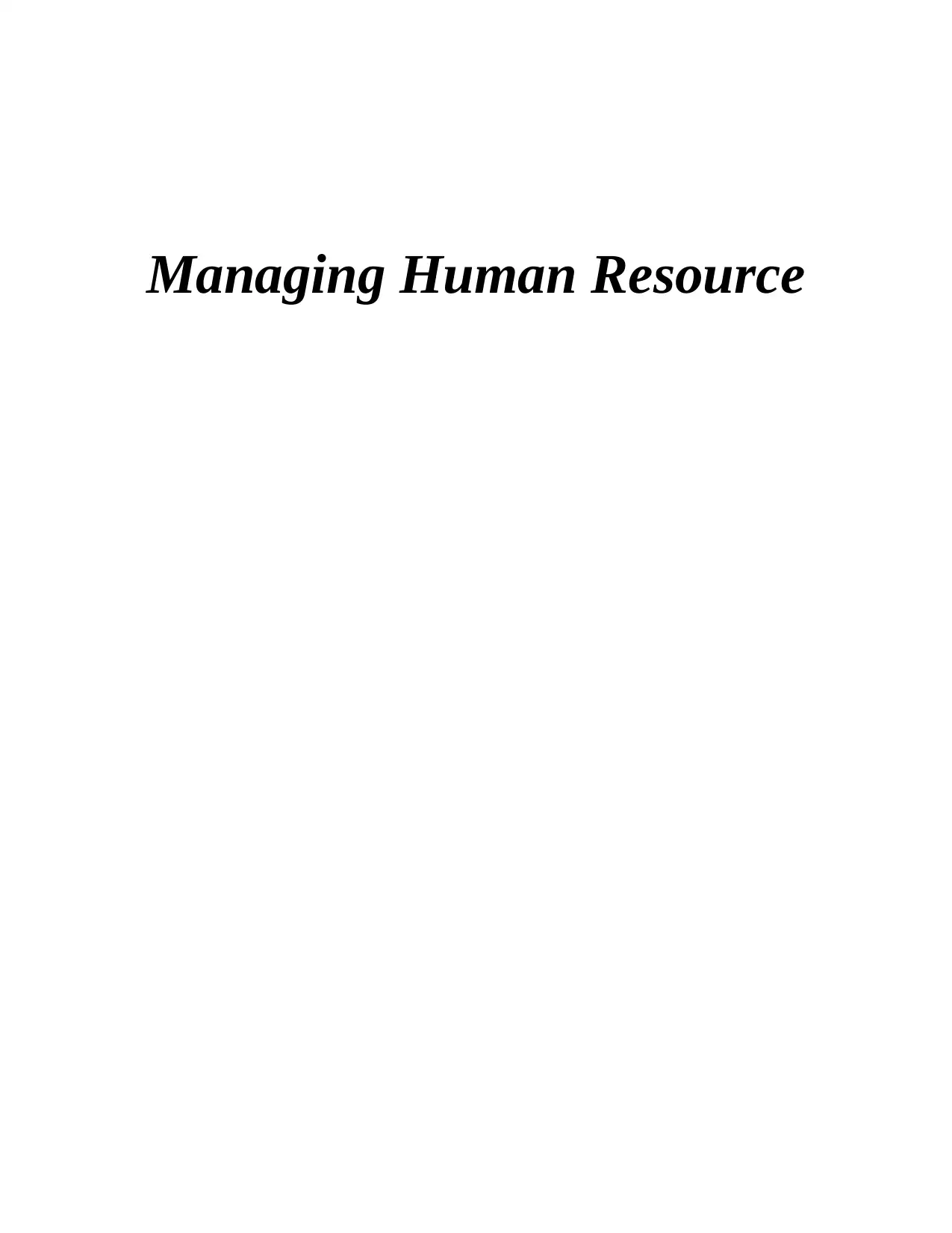
Managing Human Resource
Paraphrase This Document
Need a fresh take? Get an instant paraphrase of this document with our AI Paraphraser
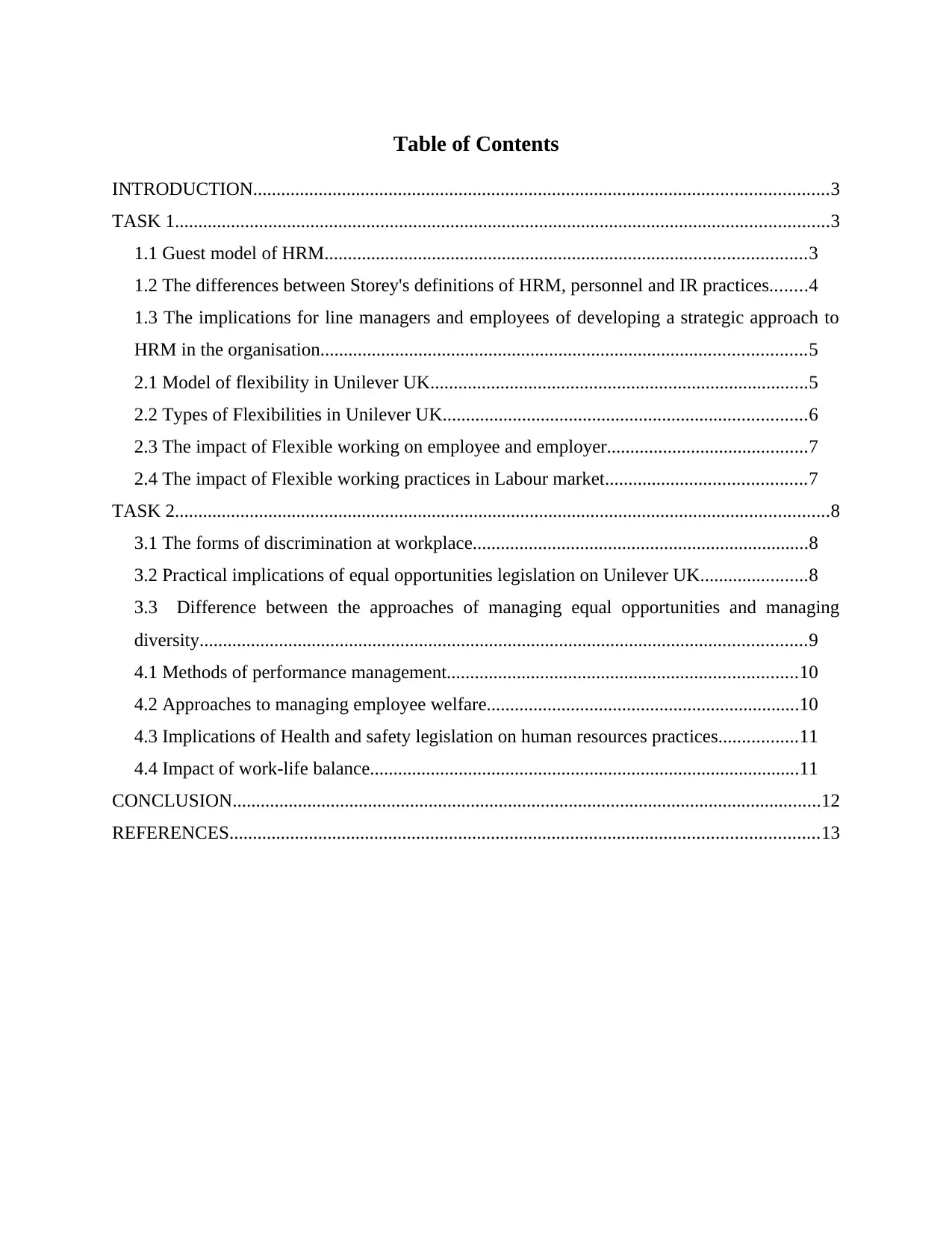
Table of Contents
INTRODUCTION...........................................................................................................................3
TASK 1............................................................................................................................................3
1.1 Guest model of HRM.......................................................................................................3
1.2 The differences between Storey's definitions of HRM, personnel and IR practices........4
1.3 The implications for line managers and employees of developing a strategic approach to
HRM in the organisation........................................................................................................5
2.1 Model of flexibility in Unilever UK.................................................................................5
2.2 Types of Flexibilities in Unilever UK..............................................................................6
2.3 The impact of Flexible working on employee and employer...........................................7
2.4 The impact of Flexible working practices in Labour market...........................................7
TASK 2............................................................................................................................................8
3.1 The forms of discrimination at workplace........................................................................8
3.2 Practical implications of equal opportunities legislation on Unilever UK.......................8
3.3 Difference between the approaches of managing equal opportunities and managing
diversity..................................................................................................................................9
4.1 Methods of performance management...........................................................................10
4.2 Approaches to managing employee welfare...................................................................10
4.3 Implications of Health and safety legislation on human resources practices.................11
4.4 Impact of work-life balance............................................................................................11
CONCLUSION..............................................................................................................................12
REFERENCES..............................................................................................................................13
INTRODUCTION...........................................................................................................................3
TASK 1............................................................................................................................................3
1.1 Guest model of HRM.......................................................................................................3
1.2 The differences between Storey's definitions of HRM, personnel and IR practices........4
1.3 The implications for line managers and employees of developing a strategic approach to
HRM in the organisation........................................................................................................5
2.1 Model of flexibility in Unilever UK.................................................................................5
2.2 Types of Flexibilities in Unilever UK..............................................................................6
2.3 The impact of Flexible working on employee and employer...........................................7
2.4 The impact of Flexible working practices in Labour market...........................................7
TASK 2............................................................................................................................................8
3.1 The forms of discrimination at workplace........................................................................8
3.2 Practical implications of equal opportunities legislation on Unilever UK.......................8
3.3 Difference between the approaches of managing equal opportunities and managing
diversity..................................................................................................................................9
4.1 Methods of performance management...........................................................................10
4.2 Approaches to managing employee welfare...................................................................10
4.3 Implications of Health and safety legislation on human resources practices.................11
4.4 Impact of work-life balance............................................................................................11
CONCLUSION..............................................................................................................................12
REFERENCES..............................................................................................................................13
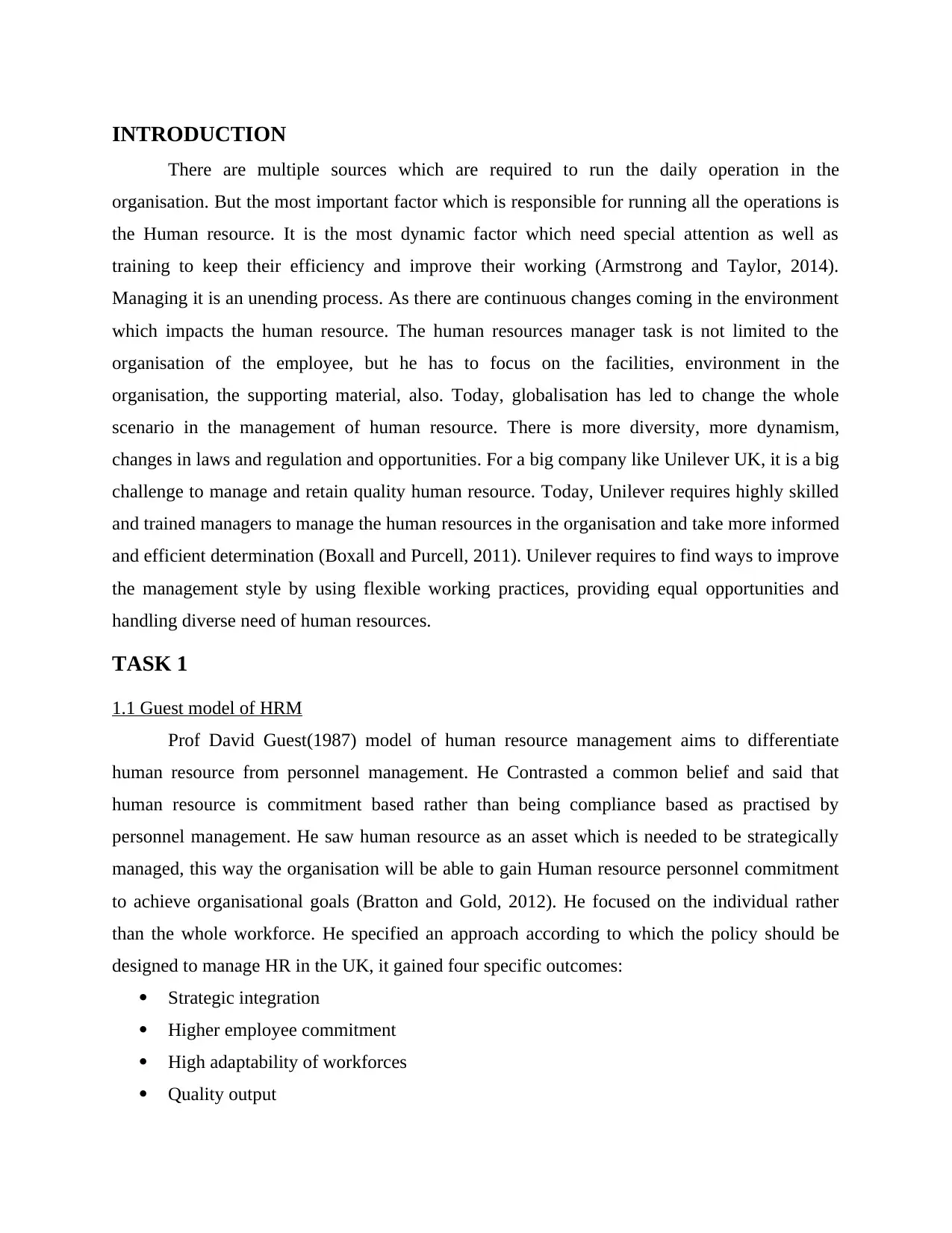
INTRODUCTION
There are multiple sources which are required to run the daily operation in the
organisation. But the most important factor which is responsible for running all the operations is
the Human resource. It is the most dynamic factor which need special attention as well as
training to keep their efficiency and improve their working (Armstrong and Taylor, 2014).
Managing it is an unending process. As there are continuous changes coming in the environment
which impacts the human resource. The human resources manager task is not limited to the
organisation of the employee, but he has to focus on the facilities, environment in the
organisation, the supporting material, also. Today, globalisation has led to change the whole
scenario in the management of human resource. There is more diversity, more dynamism,
changes in laws and regulation and opportunities. For a big company like Unilever UK, it is a big
challenge to manage and retain quality human resource. Today, Unilever requires highly skilled
and trained managers to manage the human resources in the organisation and take more informed
and efficient determination (Boxall and Purcell, 2011). Unilever requires to find ways to improve
the management style by using flexible working practices, providing equal opportunities and
handling diverse need of human resources.
TASK 1
1.1 Guest model of HRM
Prof David Guest(1987) model of human resource management aims to differentiate
human resource from personnel management. He Contrasted a common belief and said that
human resource is commitment based rather than being compliance based as practised by
personnel management. He saw human resource as an asset which is needed to be strategically
managed, this way the organisation will be able to gain Human resource personnel commitment
to achieve organisational goals (Bratton and Gold, 2012). He focused on the individual rather
than the whole workforce. He specified an approach according to which the policy should be
designed to manage HR in the UK, it gained four specific outcomes:
Strategic integration
Higher employee commitment
High adaptability of workforces
Quality output
There are multiple sources which are required to run the daily operation in the
organisation. But the most important factor which is responsible for running all the operations is
the Human resource. It is the most dynamic factor which need special attention as well as
training to keep their efficiency and improve their working (Armstrong and Taylor, 2014).
Managing it is an unending process. As there are continuous changes coming in the environment
which impacts the human resource. The human resources manager task is not limited to the
organisation of the employee, but he has to focus on the facilities, environment in the
organisation, the supporting material, also. Today, globalisation has led to change the whole
scenario in the management of human resource. There is more diversity, more dynamism,
changes in laws and regulation and opportunities. For a big company like Unilever UK, it is a big
challenge to manage and retain quality human resource. Today, Unilever requires highly skilled
and trained managers to manage the human resources in the organisation and take more informed
and efficient determination (Boxall and Purcell, 2011). Unilever requires to find ways to improve
the management style by using flexible working practices, providing equal opportunities and
handling diverse need of human resources.
TASK 1
1.1 Guest model of HRM
Prof David Guest(1987) model of human resource management aims to differentiate
human resource from personnel management. He Contrasted a common belief and said that
human resource is commitment based rather than being compliance based as practised by
personnel management. He saw human resource as an asset which is needed to be strategically
managed, this way the organisation will be able to gain Human resource personnel commitment
to achieve organisational goals (Bratton and Gold, 2012). He focused on the individual rather
than the whole workforce. He specified an approach according to which the policy should be
designed to manage HR in the UK, it gained four specific outcomes:
Strategic integration
Higher employee commitment
High adaptability of workforces
Quality output
⊘ This is a preview!⊘
Do you want full access?
Subscribe today to unlock all pages.

Trusted by 1+ million students worldwide
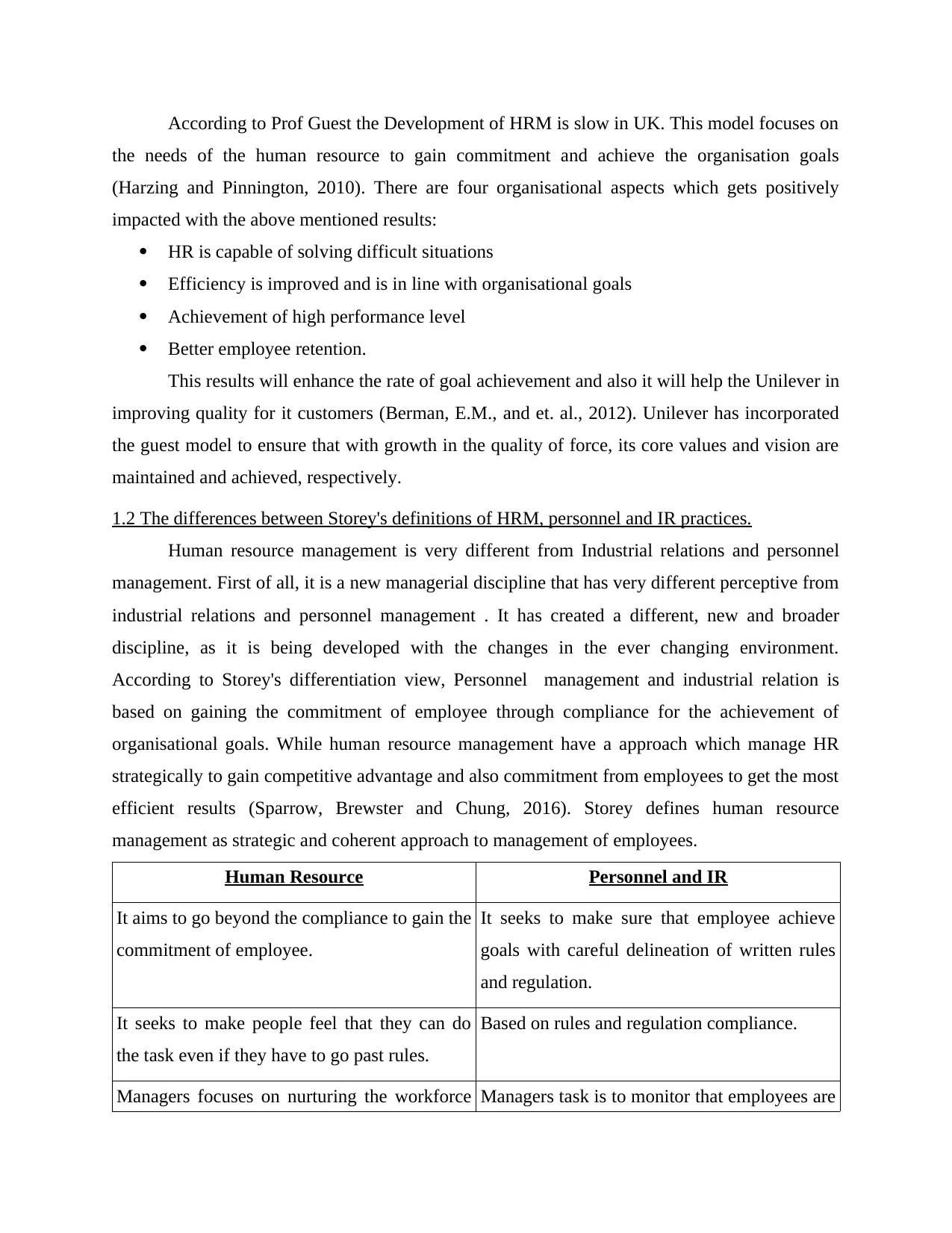
According to Prof Guest the Development of HRM is slow in UK. This model focuses on
the needs of the human resource to gain commitment and achieve the organisation goals
(Harzing and Pinnington, 2010). There are four organisational aspects which gets positively
impacted with the above mentioned results:
HR is capable of solving difficult situations
Efficiency is improved and is in line with organisational goals
Achievement of high performance level
Better employee retention.
This results will enhance the rate of goal achievement and also it will help the Unilever in
improving quality for it customers (Berman, E.M., and et. al., 2012). Unilever has incorporated
the guest model to ensure that with growth in the quality of force, its core values and vision are
maintained and achieved, respectively.
1.2 The differences between Storey's definitions of HRM, personnel and IR practices.
Human resource management is very different from Industrial relations and personnel
management. First of all, it is a new managerial discipline that has very different perceptive from
industrial relations and personnel management . It has created a different, new and broader
discipline, as it is being developed with the changes in the ever changing environment.
According to Storey's differentiation view, Personnel management and industrial relation is
based on gaining the commitment of employee through compliance for the achievement of
organisational goals. While human resource management have a approach which manage HR
strategically to gain competitive advantage and also commitment from employees to get the most
efficient results (Sparrow, Brewster and Chung, 2016). Storey defines human resource
management as strategic and coherent approach to management of employees.
Human Resource Personnel and IR
It aims to go beyond the compliance to gain the
commitment of employee.
It seeks to make sure that employee achieve
goals with careful delineation of written rules
and regulation.
It seeks to make people feel that they can do
the task even if they have to go past rules.
Based on rules and regulation compliance.
Managers focuses on nurturing the workforce Managers task is to monitor that employees are
the needs of the human resource to gain commitment and achieve the organisation goals
(Harzing and Pinnington, 2010). There are four organisational aspects which gets positively
impacted with the above mentioned results:
HR is capable of solving difficult situations
Efficiency is improved and is in line with organisational goals
Achievement of high performance level
Better employee retention.
This results will enhance the rate of goal achievement and also it will help the Unilever in
improving quality for it customers (Berman, E.M., and et. al., 2012). Unilever has incorporated
the guest model to ensure that with growth in the quality of force, its core values and vision are
maintained and achieved, respectively.
1.2 The differences between Storey's definitions of HRM, personnel and IR practices.
Human resource management is very different from Industrial relations and personnel
management. First of all, it is a new managerial discipline that has very different perceptive from
industrial relations and personnel management . It has created a different, new and broader
discipline, as it is being developed with the changes in the ever changing environment.
According to Storey's differentiation view, Personnel management and industrial relation is
based on gaining the commitment of employee through compliance for the achievement of
organisational goals. While human resource management have a approach which manage HR
strategically to gain competitive advantage and also commitment from employees to get the most
efficient results (Sparrow, Brewster and Chung, 2016). Storey defines human resource
management as strategic and coherent approach to management of employees.
Human Resource Personnel and IR
It aims to go beyond the compliance to gain the
commitment of employee.
It seeks to make sure that employee achieve
goals with careful delineation of written rules
and regulation.
It seeks to make people feel that they can do
the task even if they have to go past rules.
Based on rules and regulation compliance.
Managers focuses on nurturing the workforce Managers task is to monitor that employees are
Paraphrase This Document
Need a fresh take? Get an instant paraphrase of this document with our AI Paraphraser

into a better and efficient one. doing the task as specified to them.
It is based on values and vision. It is based on norms, customs and practice.
1.3 The implications for line managers and employees of developing a strategic approach to
HRM in the organisation.
Whenever, new strategic approaches are developed it have implications on the line
managers and the employees. It happens same in Unilever too, as any new strategic approach has
to be integrated in the system by the line managers and he has to make sure everyone understand
the new approach (Storey, 2014). These new approaches have to be integrated with the
leadership style, organisation culture, business policies, and production goals. The new
approaches are developed to keep up the new changes coming in the market, it changes with
every dynamic move which takes place and have significant impact on the human resource. This
dynamic environment presents challenges as well as opportunities to the line managers at
Unilever to mange and make the HR forces more effective There are certain methods in HR that
can support them:
They need to create desire in the mind of line managers so as to make them take the
responsibilities.
Proper support is required by the line managers from HR.
HR manager has to look at ways to grow the capacity of the line manager who are
restricted to their range of duties.
The HR manager need to makes sure that line managers get the required training
opportunities, so they develop all the required competencies and compete in the dynamic
market.
For employees, there are many implications which range from job security, fluctuation of
remuneration and bonuses (Daley, 2012).. These all are based on their performance and
contribution to the goal achievement.
2.1 Model of flexibility in Unilever UK.
To face the dynamics of the market it has become important for the managers to make the
system and the process of the organisation much more flexible(Guest, 2011). It depends on the
HR manager to identify the requirement of the work which require specialised employee and to
attain the HR manager can change when, where and how will that employee work to get the
It is based on values and vision. It is based on norms, customs and practice.
1.3 The implications for line managers and employees of developing a strategic approach to
HRM in the organisation.
Whenever, new strategic approaches are developed it have implications on the line
managers and the employees. It happens same in Unilever too, as any new strategic approach has
to be integrated in the system by the line managers and he has to make sure everyone understand
the new approach (Storey, 2014). These new approaches have to be integrated with the
leadership style, organisation culture, business policies, and production goals. The new
approaches are developed to keep up the new changes coming in the market, it changes with
every dynamic move which takes place and have significant impact on the human resource. This
dynamic environment presents challenges as well as opportunities to the line managers at
Unilever to mange and make the HR forces more effective There are certain methods in HR that
can support them:
They need to create desire in the mind of line managers so as to make them take the
responsibilities.
Proper support is required by the line managers from HR.
HR manager has to look at ways to grow the capacity of the line manager who are
restricted to their range of duties.
The HR manager need to makes sure that line managers get the required training
opportunities, so they develop all the required competencies and compete in the dynamic
market.
For employees, there are many implications which range from job security, fluctuation of
remuneration and bonuses (Daley, 2012).. These all are based on their performance and
contribution to the goal achievement.
2.1 Model of flexibility in Unilever UK.
To face the dynamics of the market it has become important for the managers to make the
system and the process of the organisation much more flexible(Guest, 2011). It depends on the
HR manager to identify the requirement of the work which require specialised employee and to
attain the HR manager can change when, where and how will that employee work to get the
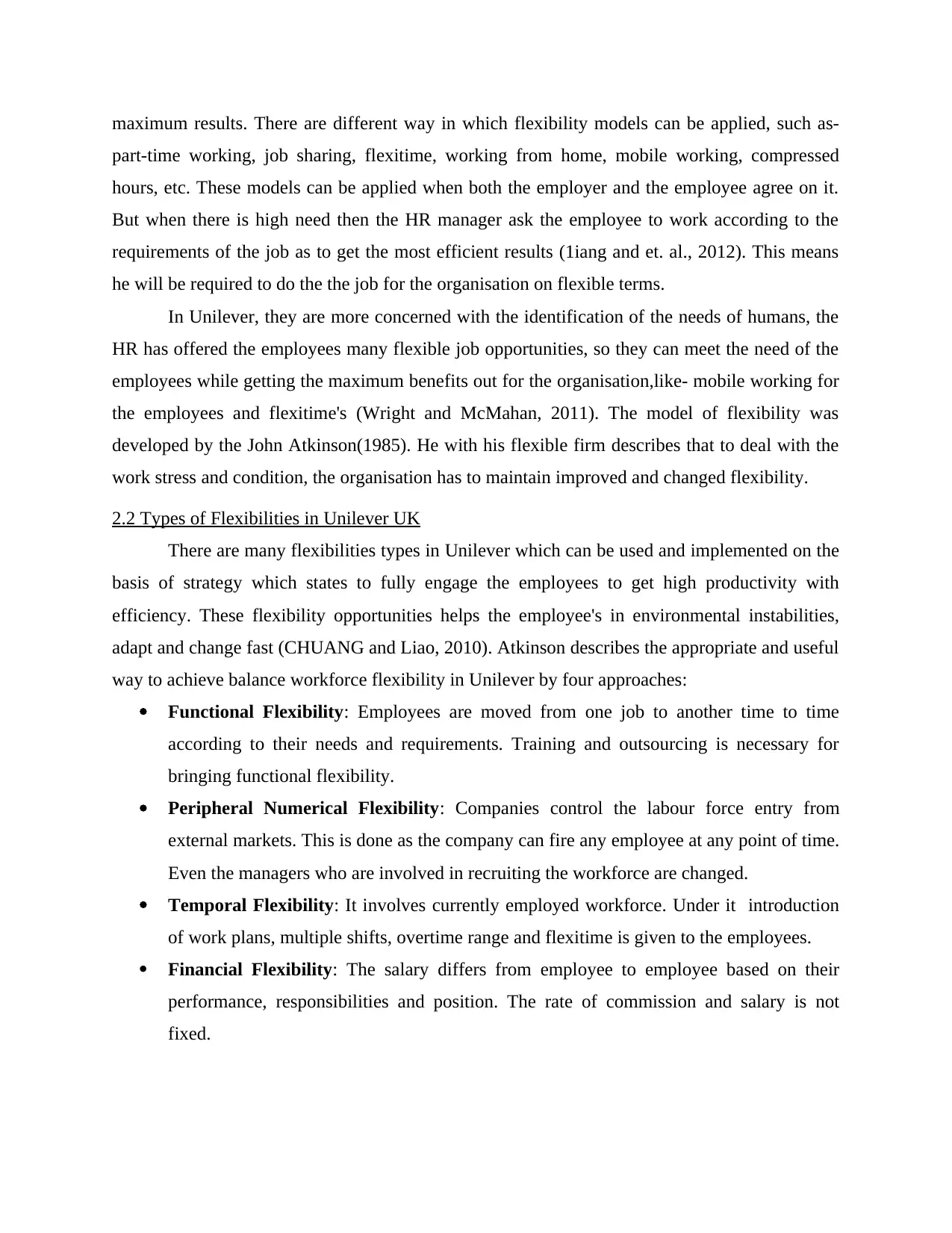
maximum results. There are different way in which flexibility models can be applied, such as-
part-time working, job sharing, flexitime, working from home, mobile working, compressed
hours, etc. These models can be applied when both the employer and the employee agree on it.
But when there is high need then the HR manager ask the employee to work according to the
requirements of the job as to get the most efficient results (1iang and et. al., 2012). This means
he will be required to do the the job for the organisation on flexible terms.
In Unilever, they are more concerned with the identification of the needs of humans, the
HR has offered the employees many flexible job opportunities, so they can meet the need of the
employees while getting the maximum benefits out for the organisation,like- mobile working for
the employees and flexitime's (Wright and McMahan, 2011). The model of flexibility was
developed by the John Atkinson(1985). He with his flexible firm describes that to deal with the
work stress and condition, the organisation has to maintain improved and changed flexibility.
2.2 Types of Flexibilities in Unilever UK
There are many flexibilities types in Unilever which can be used and implemented on the
basis of strategy which states to fully engage the employees to get high productivity with
efficiency. These flexibility opportunities helps the employee's in environmental instabilities,
adapt and change fast (CHUANG and Liao, 2010). Atkinson describes the appropriate and useful
way to achieve balance workforce flexibility in Unilever by four approaches:
Functional Flexibility: Employees are moved from one job to another time to time
according to their needs and requirements. Training and outsourcing is necessary for
bringing functional flexibility.
Peripheral Numerical Flexibility: Companies control the labour force entry from
external markets. This is done as the company can fire any employee at any point of time.
Even the managers who are involved in recruiting the workforce are changed.
Temporal Flexibility: It involves currently employed workforce. Under it introduction
of work plans, multiple shifts, overtime range and flexitime is given to the employees.
Financial Flexibility: The salary differs from employee to employee based on their
performance, responsibilities and position. The rate of commission and salary is not
fixed.
part-time working, job sharing, flexitime, working from home, mobile working, compressed
hours, etc. These models can be applied when both the employer and the employee agree on it.
But when there is high need then the HR manager ask the employee to work according to the
requirements of the job as to get the most efficient results (1iang and et. al., 2012). This means
he will be required to do the the job for the organisation on flexible terms.
In Unilever, they are more concerned with the identification of the needs of humans, the
HR has offered the employees many flexible job opportunities, so they can meet the need of the
employees while getting the maximum benefits out for the organisation,like- mobile working for
the employees and flexitime's (Wright and McMahan, 2011). The model of flexibility was
developed by the John Atkinson(1985). He with his flexible firm describes that to deal with the
work stress and condition, the organisation has to maintain improved and changed flexibility.
2.2 Types of Flexibilities in Unilever UK
There are many flexibilities types in Unilever which can be used and implemented on the
basis of strategy which states to fully engage the employees to get high productivity with
efficiency. These flexibility opportunities helps the employee's in environmental instabilities,
adapt and change fast (CHUANG and Liao, 2010). Atkinson describes the appropriate and useful
way to achieve balance workforce flexibility in Unilever by four approaches:
Functional Flexibility: Employees are moved from one job to another time to time
according to their needs and requirements. Training and outsourcing is necessary for
bringing functional flexibility.
Peripheral Numerical Flexibility: Companies control the labour force entry from
external markets. This is done as the company can fire any employee at any point of time.
Even the managers who are involved in recruiting the workforce are changed.
Temporal Flexibility: It involves currently employed workforce. Under it introduction
of work plans, multiple shifts, overtime range and flexitime is given to the employees.
Financial Flexibility: The salary differs from employee to employee based on their
performance, responsibilities and position. The rate of commission and salary is not
fixed.
⊘ This is a preview!⊘
Do you want full access?
Subscribe today to unlock all pages.

Trusted by 1+ million students worldwide
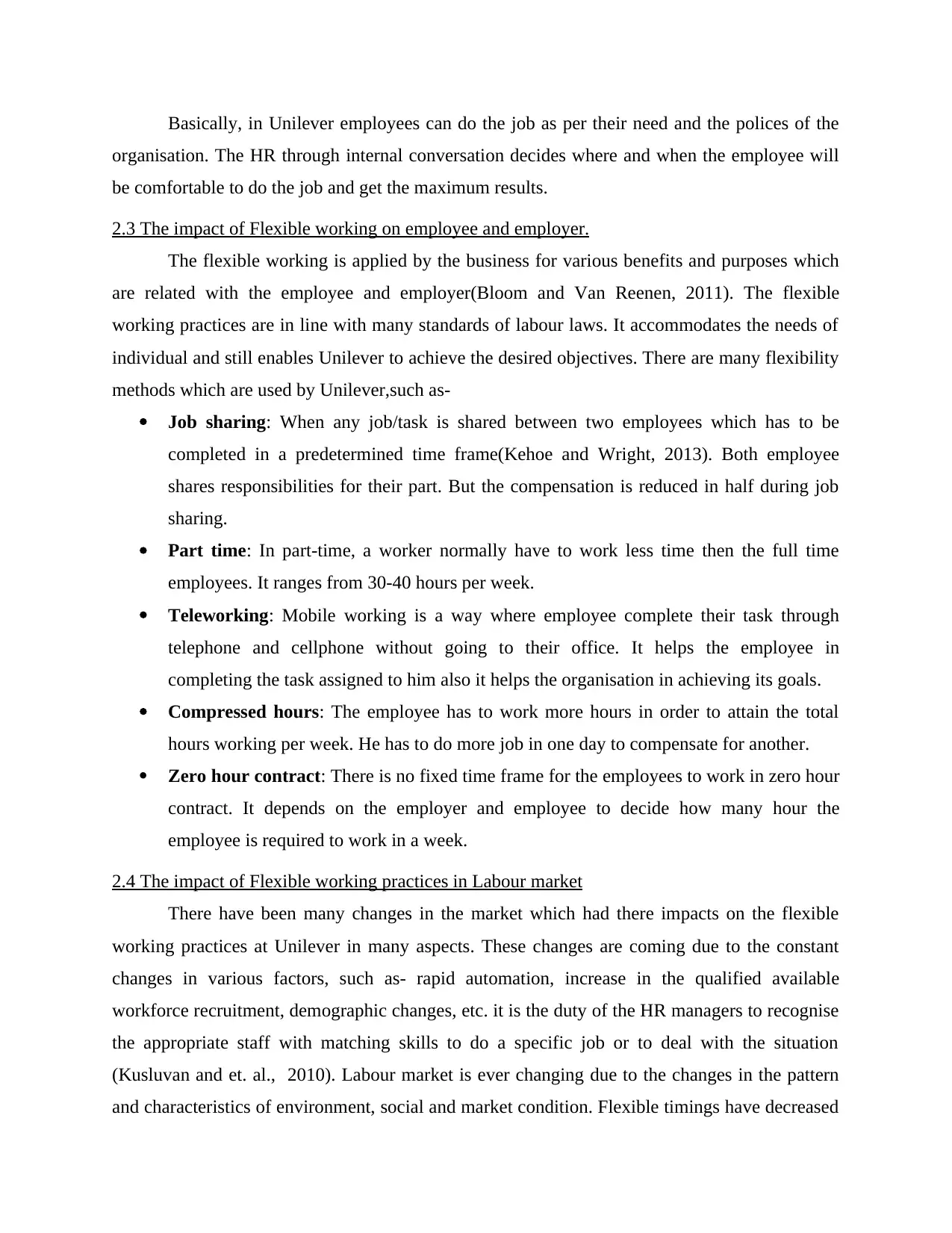
Basically, in Unilever employees can do the job as per their need and the polices of the
organisation. The HR through internal conversation decides where and when the employee will
be comfortable to do the job and get the maximum results.
2.3 The impact of Flexible working on employee and employer.
The flexible working is applied by the business for various benefits and purposes which
are related with the employee and employer(Bloom and Van Reenen, 2011). The flexible
working practices are in line with many standards of labour laws. It accommodates the needs of
individual and still enables Unilever to achieve the desired objectives. There are many flexibility
methods which are used by Unilever,such as-
Job sharing: When any job/task is shared between two employees which has to be
completed in a predetermined time frame(Kehoe and Wright, 2013). Both employee
shares responsibilities for their part. But the compensation is reduced in half during job
sharing.
Part time: In part-time, a worker normally have to work less time then the full time
employees. It ranges from 30-40 hours per week.
Teleworking: Mobile working is a way where employee complete their task through
telephone and cellphone without going to their office. It helps the employee in
completing the task assigned to him also it helps the organisation in achieving its goals.
Compressed hours: The employee has to work more hours in order to attain the total
hours working per week. He has to do more job in one day to compensate for another.
Zero hour contract: There is no fixed time frame for the employees to work in zero hour
contract. It depends on the employer and employee to decide how many hour the
employee is required to work in a week.
2.4 The impact of Flexible working practices in Labour market
There have been many changes in the market which had there impacts on the flexible
working practices at Unilever in many aspects. These changes are coming due to the constant
changes in various factors, such as- rapid automation, increase in the qualified available
workforce recruitment, demographic changes, etc. it is the duty of the HR managers to recognise
the appropriate staff with matching skills to do a specific job or to deal with the situation
(Kusluvan and et. al., 2010). Labour market is ever changing due to the changes in the pattern
and characteristics of environment, social and market condition. Flexible timings have decreased
organisation. The HR through internal conversation decides where and when the employee will
be comfortable to do the job and get the maximum results.
2.3 The impact of Flexible working on employee and employer.
The flexible working is applied by the business for various benefits and purposes which
are related with the employee and employer(Bloom and Van Reenen, 2011). The flexible
working practices are in line with many standards of labour laws. It accommodates the needs of
individual and still enables Unilever to achieve the desired objectives. There are many flexibility
methods which are used by Unilever,such as-
Job sharing: When any job/task is shared between two employees which has to be
completed in a predetermined time frame(Kehoe and Wright, 2013). Both employee
shares responsibilities for their part. But the compensation is reduced in half during job
sharing.
Part time: In part-time, a worker normally have to work less time then the full time
employees. It ranges from 30-40 hours per week.
Teleworking: Mobile working is a way where employee complete their task through
telephone and cellphone without going to their office. It helps the employee in
completing the task assigned to him also it helps the organisation in achieving its goals.
Compressed hours: The employee has to work more hours in order to attain the total
hours working per week. He has to do more job in one day to compensate for another.
Zero hour contract: There is no fixed time frame for the employees to work in zero hour
contract. It depends on the employer and employee to decide how many hour the
employee is required to work in a week.
2.4 The impact of Flexible working practices in Labour market
There have been many changes in the market which had there impacts on the flexible
working practices at Unilever in many aspects. These changes are coming due to the constant
changes in various factors, such as- rapid automation, increase in the qualified available
workforce recruitment, demographic changes, etc. it is the duty of the HR managers to recognise
the appropriate staff with matching skills to do a specific job or to deal with the situation
(Kusluvan and et. al., 2010). Labour market is ever changing due to the changes in the pattern
and characteristics of environment, social and market condition. Flexible timings have decreased
Paraphrase This Document
Need a fresh take? Get an instant paraphrase of this document with our AI Paraphraser

the expenditure of Unilever on the human resource as they have to spend less and still they are
getting the job done with efficiency and higher productivity (Jabbour and et. al., 2013). Unilever
has changed it technique of finding the best personnel with specialised talents to the personnel
with multiple talents. The implementation of flexibility timings has allowed Unilever in
determining where and when the employee is getting the work done in most efficient manner.
This allows them in decreasing the cost of the work and invest it somewhere else.
Workplace flexibility should change according to the changes in labour market. The
demographics changes has an impact on the Unilever, the availability of people who are
qualified and from different background to be employed In the organisation is increasing.
TASK 2
3.1 The forms of discrimination at workplace
There are many forms of discrimination which occurs in the organisation all over the
world. Even a organisation as big as Unilever is not safe from discrimination. According to
International labour organisation, discrimination at workplace is of different patterns, such as-
age, race, religion and cultural based (Ployhart and Moliterno, 2011). Discrimination stop the
distribution of equal opportunities to all. The employee performance, motivation, skill
development, standards fall when discrimination takes place in any organisation. This lead to the
failure in achieving the organisation goals and objectives. Discrimination on the basis of
disability also occurs as the ex employee from Unilever stated that he faced discrimination
because he was disabled. If this activity of discrimination rises in the organisation it will lead to
deterioration in companies image in the market. The customers will also boycott the company as
discrimination is an emotional topic which affects the customer and market directly. Unilever has
made up different policies and procedures to reduce or rectify the chances of discrimination in
the company . As Unilever has to manage a very diversified workforce, it has employed all the
measures to make sure nobody gets discriminated on the basis of Age, Religion, Compensation,
Disability, Race and Different background.
3.2 Practical implications of equal opportunities legislation on Unilever UK.
Getting equal opportunities is the basic right of every human being (Gruman and Saks,
2011). As Equal opportunities make a person be more competitive and have equal chances of
growing to new heights. Unilever understands the need of providing equal opportunities to its
getting the job done with efficiency and higher productivity (Jabbour and et. al., 2013). Unilever
has changed it technique of finding the best personnel with specialised talents to the personnel
with multiple talents. The implementation of flexibility timings has allowed Unilever in
determining where and when the employee is getting the work done in most efficient manner.
This allows them in decreasing the cost of the work and invest it somewhere else.
Workplace flexibility should change according to the changes in labour market. The
demographics changes has an impact on the Unilever, the availability of people who are
qualified and from different background to be employed In the organisation is increasing.
TASK 2
3.1 The forms of discrimination at workplace
There are many forms of discrimination which occurs in the organisation all over the
world. Even a organisation as big as Unilever is not safe from discrimination. According to
International labour organisation, discrimination at workplace is of different patterns, such as-
age, race, religion and cultural based (Ployhart and Moliterno, 2011). Discrimination stop the
distribution of equal opportunities to all. The employee performance, motivation, skill
development, standards fall when discrimination takes place in any organisation. This lead to the
failure in achieving the organisation goals and objectives. Discrimination on the basis of
disability also occurs as the ex employee from Unilever stated that he faced discrimination
because he was disabled. If this activity of discrimination rises in the organisation it will lead to
deterioration in companies image in the market. The customers will also boycott the company as
discrimination is an emotional topic which affects the customer and market directly. Unilever has
made up different policies and procedures to reduce or rectify the chances of discrimination in
the company . As Unilever has to manage a very diversified workforce, it has employed all the
measures to make sure nobody gets discriminated on the basis of Age, Religion, Compensation,
Disability, Race and Different background.
3.2 Practical implications of equal opportunities legislation on Unilever UK.
Getting equal opportunities is the basic right of every human being (Gruman and Saks,
2011). As Equal opportunities make a person be more competitive and have equal chances of
growing to new heights. Unilever understands the need of providing equal opportunities to its
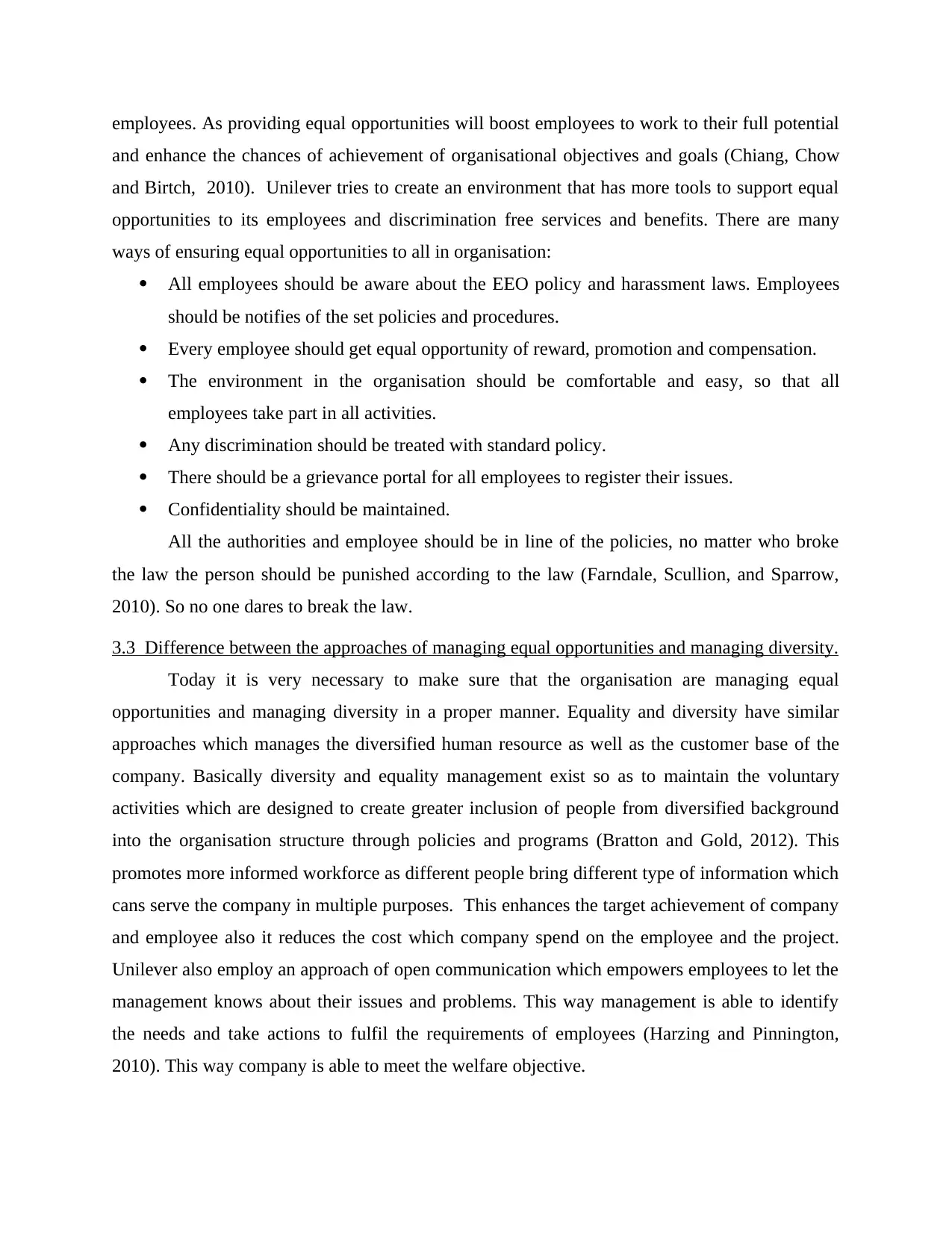
employees. As providing equal opportunities will boost employees to work to their full potential
and enhance the chances of achievement of organisational objectives and goals (Chiang, Chow
and Birtch, 2010). Unilever tries to create an environment that has more tools to support equal
opportunities to its employees and discrimination free services and benefits. There are many
ways of ensuring equal opportunities to all in organisation:
All employees should be aware about the EEO policy and harassment laws. Employees
should be notifies of the set policies and procedures.
Every employee should get equal opportunity of reward, promotion and compensation.
The environment in the organisation should be comfortable and easy, so that all
employees take part in all activities.
Any discrimination should be treated with standard policy.
There should be a grievance portal for all employees to register their issues.
Confidentiality should be maintained.
All the authorities and employee should be in line of the policies, no matter who broke
the law the person should be punished according to the law (Farndale, Scullion, and Sparrow,
2010). So no one dares to break the law.
3.3 Difference between the approaches of managing equal opportunities and managing diversity.
Today it is very necessary to make sure that the organisation are managing equal
opportunities and managing diversity in a proper manner. Equality and diversity have similar
approaches which manages the diversified human resource as well as the customer base of the
company. Basically diversity and equality management exist so as to maintain the voluntary
activities which are designed to create greater inclusion of people from diversified background
into the organisation structure through policies and programs (Bratton and Gold, 2012). This
promotes more informed workforce as different people bring different type of information which
cans serve the company in multiple purposes. This enhances the target achievement of company
and employee also it reduces the cost which company spend on the employee and the project.
Unilever also employ an approach of open communication which empowers employees to let the
management knows about their issues and problems. This way management is able to identify
the needs and take actions to fulfil the requirements of employees (Harzing and Pinnington,
2010). This way company is able to meet the welfare objective.
and enhance the chances of achievement of organisational objectives and goals (Chiang, Chow
and Birtch, 2010). Unilever tries to create an environment that has more tools to support equal
opportunities to its employees and discrimination free services and benefits. There are many
ways of ensuring equal opportunities to all in organisation:
All employees should be aware about the EEO policy and harassment laws. Employees
should be notifies of the set policies and procedures.
Every employee should get equal opportunity of reward, promotion and compensation.
The environment in the organisation should be comfortable and easy, so that all
employees take part in all activities.
Any discrimination should be treated with standard policy.
There should be a grievance portal for all employees to register their issues.
Confidentiality should be maintained.
All the authorities and employee should be in line of the policies, no matter who broke
the law the person should be punished according to the law (Farndale, Scullion, and Sparrow,
2010). So no one dares to break the law.
3.3 Difference between the approaches of managing equal opportunities and managing diversity.
Today it is very necessary to make sure that the organisation are managing equal
opportunities and managing diversity in a proper manner. Equality and diversity have similar
approaches which manages the diversified human resource as well as the customer base of the
company. Basically diversity and equality management exist so as to maintain the voluntary
activities which are designed to create greater inclusion of people from diversified background
into the organisation structure through policies and programs (Bratton and Gold, 2012). This
promotes more informed workforce as different people bring different type of information which
cans serve the company in multiple purposes. This enhances the target achievement of company
and employee also it reduces the cost which company spend on the employee and the project.
Unilever also employ an approach of open communication which empowers employees to let the
management knows about their issues and problems. This way management is able to identify
the needs and take actions to fulfil the requirements of employees (Harzing and Pinnington,
2010). This way company is able to meet the welfare objective.
⊘ This is a preview!⊘
Do you want full access?
Subscribe today to unlock all pages.

Trusted by 1+ million students worldwide
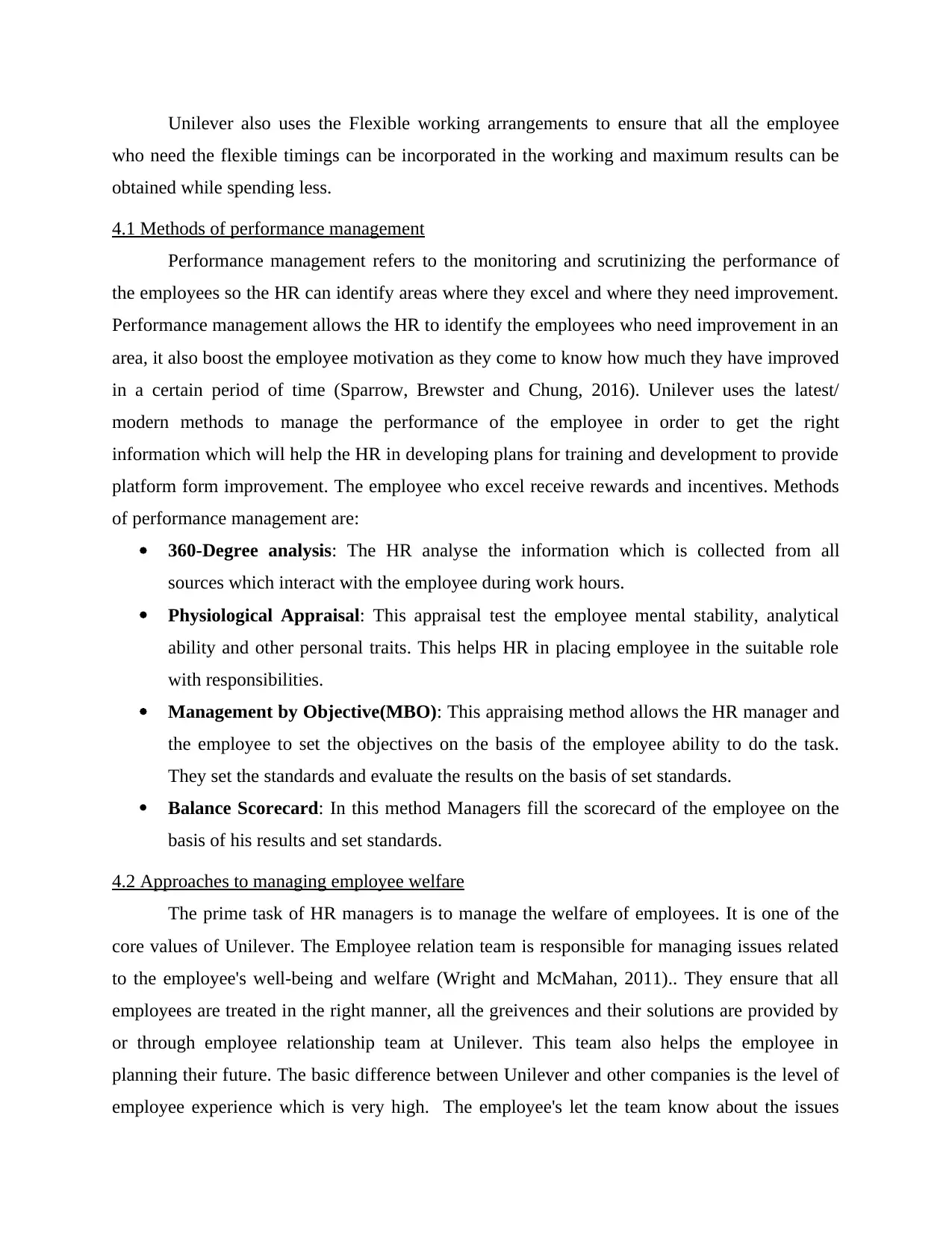
Unilever also uses the Flexible working arrangements to ensure that all the employee
who need the flexible timings can be incorporated in the working and maximum results can be
obtained while spending less.
4.1 Methods of performance management
Performance management refers to the monitoring and scrutinizing the performance of
the employees so the HR can identify areas where they excel and where they need improvement.
Performance management allows the HR to identify the employees who need improvement in an
area, it also boost the employee motivation as they come to know how much they have improved
in a certain period of time (Sparrow, Brewster and Chung, 2016). Unilever uses the latest/
modern methods to manage the performance of the employee in order to get the right
information which will help the HR in developing plans for training and development to provide
platform form improvement. The employee who excel receive rewards and incentives. Methods
of performance management are:
360-Degree analysis: The HR analyse the information which is collected from all
sources which interact with the employee during work hours.
Physiological Appraisal: This appraisal test the employee mental stability, analytical
ability and other personal traits. This helps HR in placing employee in the suitable role
with responsibilities.
Management by Objective(MBO): This appraising method allows the HR manager and
the employee to set the objectives on the basis of the employee ability to do the task.
They set the standards and evaluate the results on the basis of set standards.
Balance Scorecard: In this method Managers fill the scorecard of the employee on the
basis of his results and set standards.
4.2 Approaches to managing employee welfare
The prime task of HR managers is to manage the welfare of employees. It is one of the
core values of Unilever. The Employee relation team is responsible for managing issues related
to the employee's well-being and welfare (Wright and McMahan, 2011).. They ensure that all
employees are treated in the right manner, all the greivences and their solutions are provided by
or through employee relationship team at Unilever. This team also helps the employee in
planning their future. The basic difference between Unilever and other companies is the level of
employee experience which is very high. The employee's let the team know about the issues
who need the flexible timings can be incorporated in the working and maximum results can be
obtained while spending less.
4.1 Methods of performance management
Performance management refers to the monitoring and scrutinizing the performance of
the employees so the HR can identify areas where they excel and where they need improvement.
Performance management allows the HR to identify the employees who need improvement in an
area, it also boost the employee motivation as they come to know how much they have improved
in a certain period of time (Sparrow, Brewster and Chung, 2016). Unilever uses the latest/
modern methods to manage the performance of the employee in order to get the right
information which will help the HR in developing plans for training and development to provide
platform form improvement. The employee who excel receive rewards and incentives. Methods
of performance management are:
360-Degree analysis: The HR analyse the information which is collected from all
sources which interact with the employee during work hours.
Physiological Appraisal: This appraisal test the employee mental stability, analytical
ability and other personal traits. This helps HR in placing employee in the suitable role
with responsibilities.
Management by Objective(MBO): This appraising method allows the HR manager and
the employee to set the objectives on the basis of the employee ability to do the task.
They set the standards and evaluate the results on the basis of set standards.
Balance Scorecard: In this method Managers fill the scorecard of the employee on the
basis of his results and set standards.
4.2 Approaches to managing employee welfare
The prime task of HR managers is to manage the welfare of employees. It is one of the
core values of Unilever. The Employee relation team is responsible for managing issues related
to the employee's well-being and welfare (Wright and McMahan, 2011).. They ensure that all
employees are treated in the right manner, all the greivences and their solutions are provided by
or through employee relationship team at Unilever. This team also helps the employee in
planning their future. The basic difference between Unilever and other companies is the level of
employee experience which is very high. The employee's let the team know about the issues
Paraphrase This Document
Need a fresh take? Get an instant paraphrase of this document with our AI Paraphraser

which are a concern for them and are making them to have low level performance (CHUANG
and Liao, 2010). The team analysis the problem and once they get a suitable solution they let the
employee know. The welfare of emplyee can be outlined in two categories:
Statutary welfare schemes: Under this scheme, basic support and facilities are provided
to the employees, like- medical facility, water, sanitory, siting, rest rooms, etc.
Non- Statutory Welfare Scheme: This scheme provides healthcare, co-operation,
harassment protection, maternity leave, medical insurance service, etc.
These policies for the welfare of employee provide them better and healthy life, more
satisfying and secured working experience with improved skills (Berman, E.M., and et. al.,
2012). It also helps the HR in maintaing and controling the unions in more efficient manner.
4.3 Implications of Health and safety legislation on human resources practices
Any legislation which have any relations with organisation have its implication on it. The
health and safety legislation makes Unilever to abide by the laws of safety and well being of
employee and the society too. Health and safety act 1974 demands the company to have suitable
infrastructure which will ensure the safety and well of the employee as well as the surrounding
area. Company have to provide better medical services, rest room facilities, etc to fulfil the
requirements. The health and safety legislations holds the organisation responsible for any
happening to the employee health and well-being. Also company has to get their employee a
medical check-up from a certified hospital so as to check if they have developed any issue or
disease, then it is the responsibility of the company to provide assistance to the employee in
medical treatment.
A fully functional structure which have all the essentials of health and safety should exist
as to maintain the motivation of employees (1iang and et. al., 2012). All laws should be notified
to the employee so they know what their rights are and how they can be applied in a situation.
4.4 Impact of work-life balance
In last 50 years, human resource management has witnessed major changes. The HR
managers has to be prepared to cope up with the challenges which these changes bring in. Today
around 48% household have two working parents, which makes the childcare a challenge for the
parents. To ensure a better work life balance for the working parents companies are employing
many flexible working plans which allows one person to work from home for specific hours
(Gruman and Saks, 2011). This way parents are able to do the child care. This way companies
and Liao, 2010). The team analysis the problem and once they get a suitable solution they let the
employee know. The welfare of emplyee can be outlined in two categories:
Statutary welfare schemes: Under this scheme, basic support and facilities are provided
to the employees, like- medical facility, water, sanitory, siting, rest rooms, etc.
Non- Statutory Welfare Scheme: This scheme provides healthcare, co-operation,
harassment protection, maternity leave, medical insurance service, etc.
These policies for the welfare of employee provide them better and healthy life, more
satisfying and secured working experience with improved skills (Berman, E.M., and et. al.,
2012). It also helps the HR in maintaing and controling the unions in more efficient manner.
4.3 Implications of Health and safety legislation on human resources practices
Any legislation which have any relations with organisation have its implication on it. The
health and safety legislation makes Unilever to abide by the laws of safety and well being of
employee and the society too. Health and safety act 1974 demands the company to have suitable
infrastructure which will ensure the safety and well of the employee as well as the surrounding
area. Company have to provide better medical services, rest room facilities, etc to fulfil the
requirements. The health and safety legislations holds the organisation responsible for any
happening to the employee health and well-being. Also company has to get their employee a
medical check-up from a certified hospital so as to check if they have developed any issue or
disease, then it is the responsibility of the company to provide assistance to the employee in
medical treatment.
A fully functional structure which have all the essentials of health and safety should exist
as to maintain the motivation of employees (1iang and et. al., 2012). All laws should be notified
to the employee so they know what their rights are and how they can be applied in a situation.
4.4 Impact of work-life balance
In last 50 years, human resource management has witnessed major changes. The HR
managers has to be prepared to cope up with the challenges which these changes bring in. Today
around 48% household have two working parents, which makes the childcare a challenge for the
parents. To ensure a better work life balance for the working parents companies are employing
many flexible working plans which allows one person to work from home for specific hours
(Gruman and Saks, 2011). This way parents are able to do the child care. This way companies
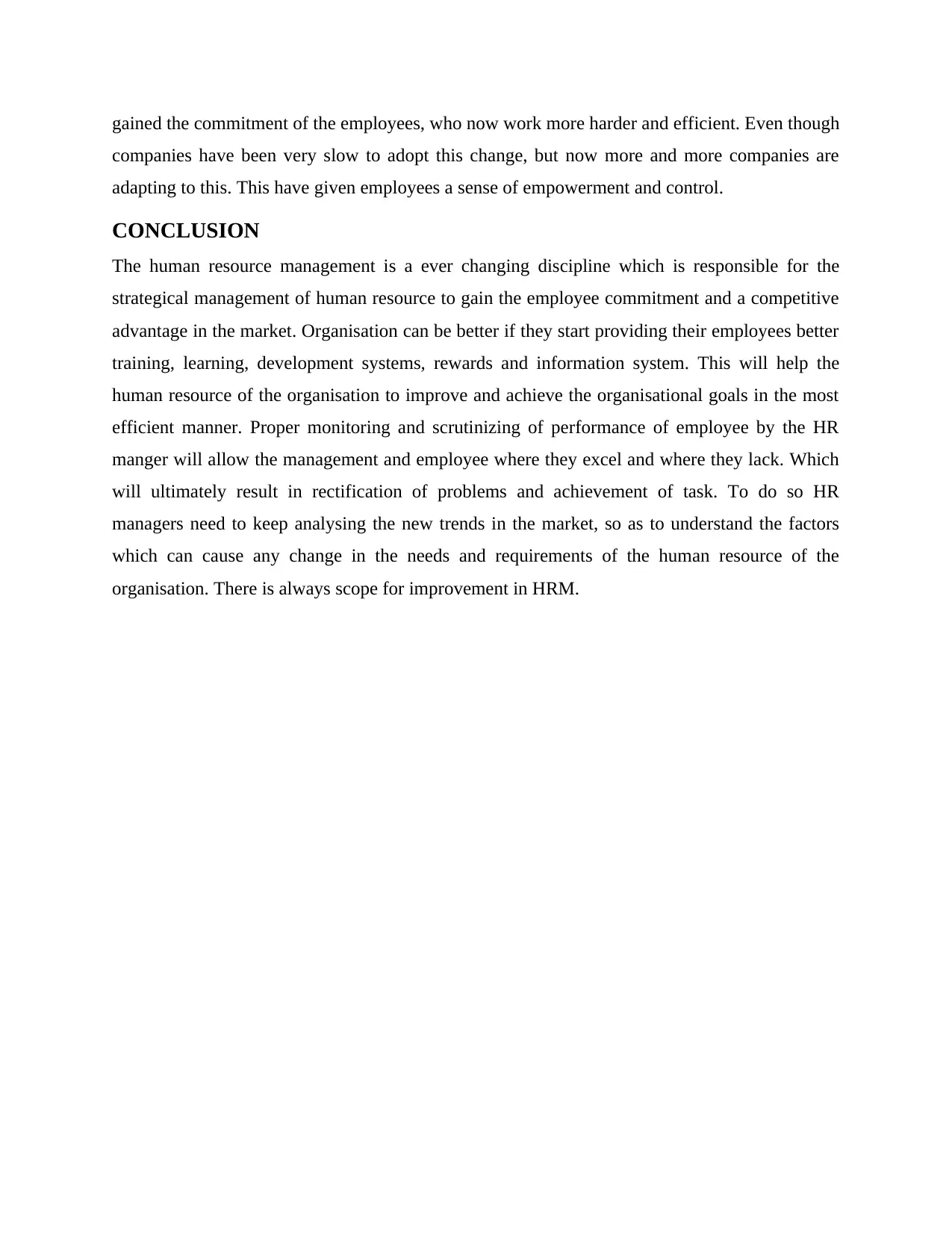
gained the commitment of the employees, who now work more harder and efficient. Even though
companies have been very slow to adopt this change, but now more and more companies are
adapting to this. This have given employees a sense of empowerment and control.
CONCLUSION
The human resource management is a ever changing discipline which is responsible for the
strategical management of human resource to gain the employee commitment and a competitive
advantage in the market. Organisation can be better if they start providing their employees better
training, learning, development systems, rewards and information system. This will help the
human resource of the organisation to improve and achieve the organisational goals in the most
efficient manner. Proper monitoring and scrutinizing of performance of employee by the HR
manger will allow the management and employee where they excel and where they lack. Which
will ultimately result in rectification of problems and achievement of task. To do so HR
managers need to keep analysing the new trends in the market, so as to understand the factors
which can cause any change in the needs and requirements of the human resource of the
organisation. There is always scope for improvement in HRM.
companies have been very slow to adopt this change, but now more and more companies are
adapting to this. This have given employees a sense of empowerment and control.
CONCLUSION
The human resource management is a ever changing discipline which is responsible for the
strategical management of human resource to gain the employee commitment and a competitive
advantage in the market. Organisation can be better if they start providing their employees better
training, learning, development systems, rewards and information system. This will help the
human resource of the organisation to improve and achieve the organisational goals in the most
efficient manner. Proper monitoring and scrutinizing of performance of employee by the HR
manger will allow the management and employee where they excel and where they lack. Which
will ultimately result in rectification of problems and achievement of task. To do so HR
managers need to keep analysing the new trends in the market, so as to understand the factors
which can cause any change in the needs and requirements of the human resource of the
organisation. There is always scope for improvement in HRM.
⊘ This is a preview!⊘
Do you want full access?
Subscribe today to unlock all pages.

Trusted by 1+ million students worldwide
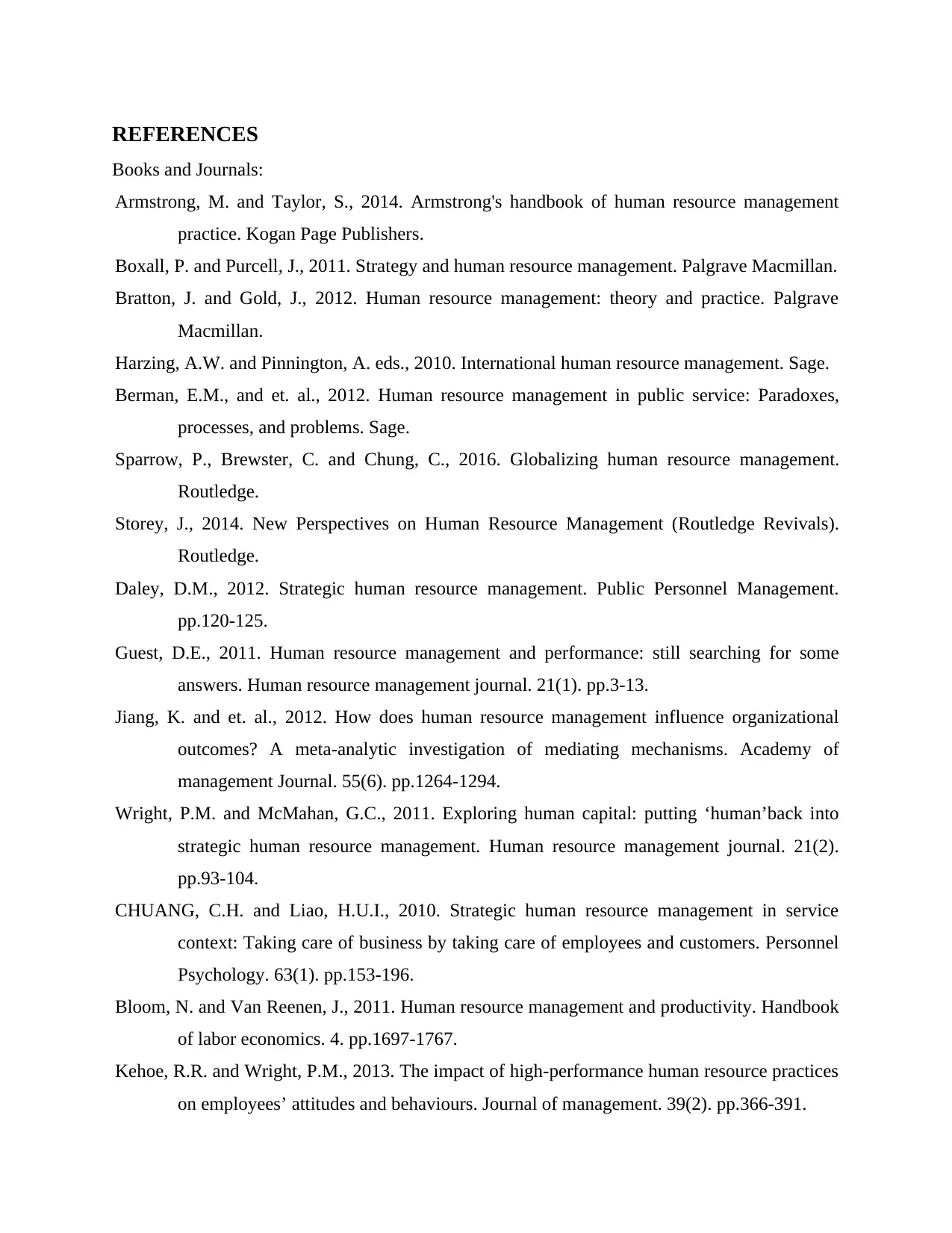
REFERENCES
Books and Journals:
Armstrong, M. and Taylor, S., 2014. Armstrong's handbook of human resource management
practice. Kogan Page Publishers.
Boxall, P. and Purcell, J., 2011. Strategy and human resource management. Palgrave Macmillan.
Bratton, J. and Gold, J., 2012. Human resource management: theory and practice. Palgrave
Macmillan.
Harzing, A.W. and Pinnington, A. eds., 2010. International human resource management. Sage.
Berman, E.M., and et. al., 2012. Human resource management in public service: Paradoxes,
processes, and problems. Sage.
Sparrow, P., Brewster, C. and Chung, C., 2016. Globalizing human resource management.
Routledge.
Storey, J., 2014. New Perspectives on Human Resource Management (Routledge Revivals).
Routledge.
Daley, D.M., 2012. Strategic human resource management. Public Personnel Management.
pp.120-125.
Guest, D.E., 2011. Human resource management and performance: still searching for some
answers. Human resource management journal. 21(1). pp.3-13.
Jiang, K. and et. al., 2012. How does human resource management influence organizational
outcomes? A meta-analytic investigation of mediating mechanisms. Academy of
management Journal. 55(6). pp.1264-1294.
Wright, P.M. and McMahan, G.C., 2011. Exploring human capital: putting ‘human’back into
strategic human resource management. Human resource management journal. 21(2).
pp.93-104.
CHUANG, C.H. and Liao, H.U.I., 2010. Strategic human resource management in service
context: Taking care of business by taking care of employees and customers. Personnel
Psychology. 63(1). pp.153-196.
Bloom, N. and Van Reenen, J., 2011. Human resource management and productivity. Handbook
of labor economics. 4. pp.1697-1767.
Kehoe, R.R. and Wright, P.M., 2013. The impact of high-performance human resource practices
on employees’ attitudes and behaviours. Journal of management. 39(2). pp.366-391.
Books and Journals:
Armstrong, M. and Taylor, S., 2014. Armstrong's handbook of human resource management
practice. Kogan Page Publishers.
Boxall, P. and Purcell, J., 2011. Strategy and human resource management. Palgrave Macmillan.
Bratton, J. and Gold, J., 2012. Human resource management: theory and practice. Palgrave
Macmillan.
Harzing, A.W. and Pinnington, A. eds., 2010. International human resource management. Sage.
Berman, E.M., and et. al., 2012. Human resource management in public service: Paradoxes,
processes, and problems. Sage.
Sparrow, P., Brewster, C. and Chung, C., 2016. Globalizing human resource management.
Routledge.
Storey, J., 2014. New Perspectives on Human Resource Management (Routledge Revivals).
Routledge.
Daley, D.M., 2012. Strategic human resource management. Public Personnel Management.
pp.120-125.
Guest, D.E., 2011. Human resource management and performance: still searching for some
answers. Human resource management journal. 21(1). pp.3-13.
Jiang, K. and et. al., 2012. How does human resource management influence organizational
outcomes? A meta-analytic investigation of mediating mechanisms. Academy of
management Journal. 55(6). pp.1264-1294.
Wright, P.M. and McMahan, G.C., 2011. Exploring human capital: putting ‘human’back into
strategic human resource management. Human resource management journal. 21(2).
pp.93-104.
CHUANG, C.H. and Liao, H.U.I., 2010. Strategic human resource management in service
context: Taking care of business by taking care of employees and customers. Personnel
Psychology. 63(1). pp.153-196.
Bloom, N. and Van Reenen, J., 2011. Human resource management and productivity. Handbook
of labor economics. 4. pp.1697-1767.
Kehoe, R.R. and Wright, P.M., 2013. The impact of high-performance human resource practices
on employees’ attitudes and behaviours. Journal of management. 39(2). pp.366-391.
Paraphrase This Document
Need a fresh take? Get an instant paraphrase of this document with our AI Paraphraser
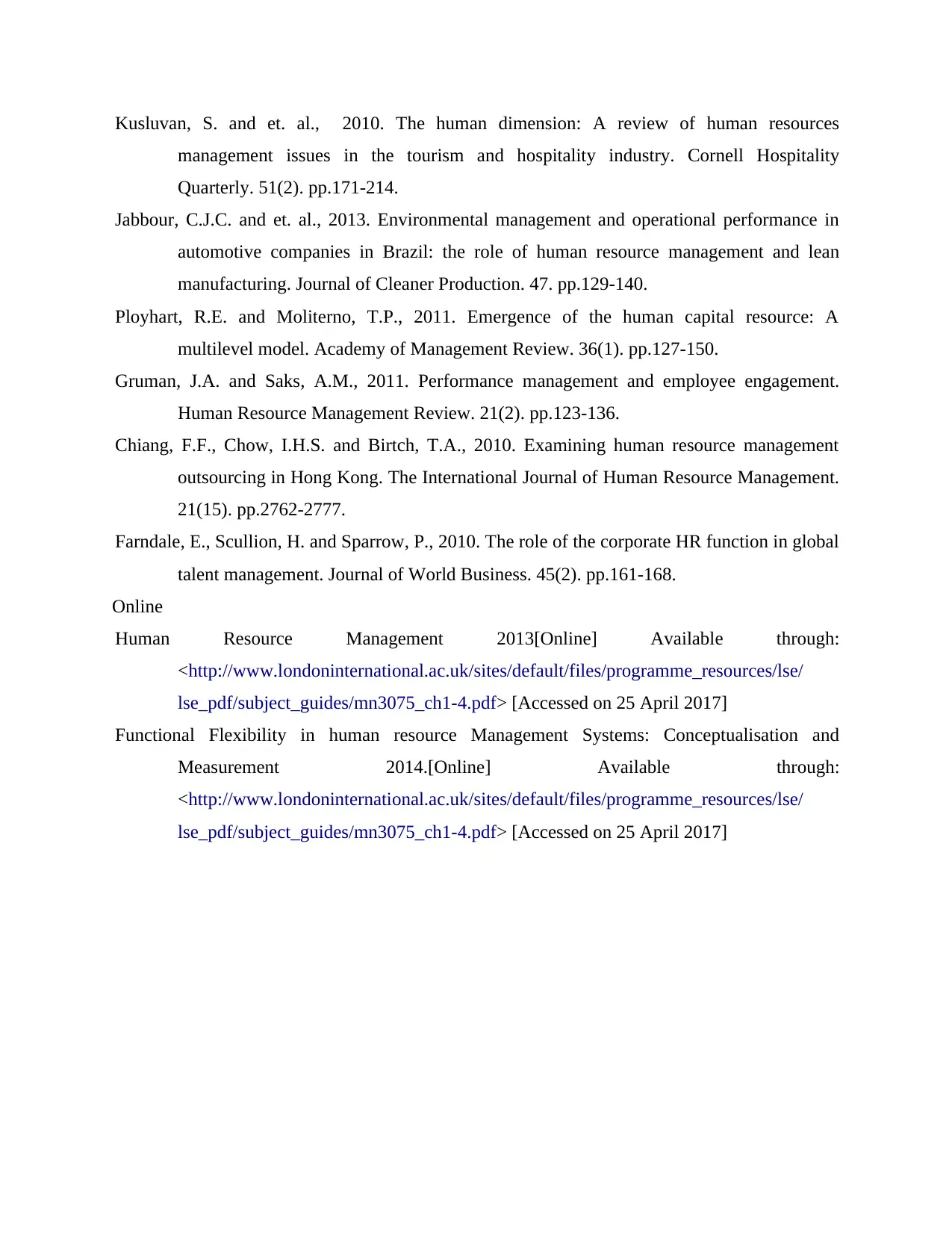
Kusluvan, S. and et. al., 2010. The human dimension: A review of human resources
management issues in the tourism and hospitality industry. Cornell Hospitality
Quarterly. 51(2). pp.171-214.
Jabbour, C.J.C. and et. al., 2013. Environmental management and operational performance in
automotive companies in Brazil: the role of human resource management and lean
manufacturing. Journal of Cleaner Production. 47. pp.129-140.
Ployhart, R.E. and Moliterno, T.P., 2011. Emergence of the human capital resource: A
multilevel model. Academy of Management Review. 36(1). pp.127-150.
Gruman, J.A. and Saks, A.M., 2011. Performance management and employee engagement.
Human Resource Management Review. 21(2). pp.123-136.
Chiang, F.F., Chow, I.H.S. and Birtch, T.A., 2010. Examining human resource management
outsourcing in Hong Kong. The International Journal of Human Resource Management.
21(15). pp.2762-2777.
Farndale, E., Scullion, H. and Sparrow, P., 2010. The role of the corporate HR function in global
talent management. Journal of World Business. 45(2). pp.161-168.
Online
Human Resource Management 2013[Online] Available through:
<http://www.londoninternational.ac.uk/sites/default/files/programme_resources/lse/
lse_pdf/subject_guides/mn3075_ch1-4.pdf> [Accessed on 25 April 2017]
Functional Flexibility in human resource Management Systems: Conceptualisation and
Measurement 2014.[Online] Available through:
<http://www.londoninternational.ac.uk/sites/default/files/programme_resources/lse/
lse_pdf/subject_guides/mn3075_ch1-4.pdf> [Accessed on 25 April 2017]
management issues in the tourism and hospitality industry. Cornell Hospitality
Quarterly. 51(2). pp.171-214.
Jabbour, C.J.C. and et. al., 2013. Environmental management and operational performance in
automotive companies in Brazil: the role of human resource management and lean
manufacturing. Journal of Cleaner Production. 47. pp.129-140.
Ployhart, R.E. and Moliterno, T.P., 2011. Emergence of the human capital resource: A
multilevel model. Academy of Management Review. 36(1). pp.127-150.
Gruman, J.A. and Saks, A.M., 2011. Performance management and employee engagement.
Human Resource Management Review. 21(2). pp.123-136.
Chiang, F.F., Chow, I.H.S. and Birtch, T.A., 2010. Examining human resource management
outsourcing in Hong Kong. The International Journal of Human Resource Management.
21(15). pp.2762-2777.
Farndale, E., Scullion, H. and Sparrow, P., 2010. The role of the corporate HR function in global
talent management. Journal of World Business. 45(2). pp.161-168.
Online
Human Resource Management 2013[Online] Available through:
<http://www.londoninternational.ac.uk/sites/default/files/programme_resources/lse/
lse_pdf/subject_guides/mn3075_ch1-4.pdf> [Accessed on 25 April 2017]
Functional Flexibility in human resource Management Systems: Conceptualisation and
Measurement 2014.[Online] Available through:
<http://www.londoninternational.ac.uk/sites/default/files/programme_resources/lse/
lse_pdf/subject_guides/mn3075_ch1-4.pdf> [Accessed on 25 April 2017]
1 out of 14
Related Documents
Your All-in-One AI-Powered Toolkit for Academic Success.
+13062052269
info@desklib.com
Available 24*7 on WhatsApp / Email
![[object Object]](/_next/static/media/star-bottom.7253800d.svg)
Unlock your academic potential
© 2024 | Zucol Services PVT LTD | All rights reserved.





